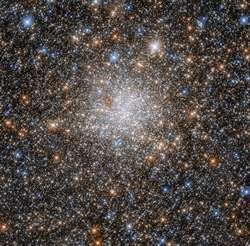NGC 1898
NGC 1898 is a globular cluster[3] in the constellation of Dorado at an approximate distance of 170,000 light-years.[1] NGC 1898 is located in the Large Magellanic Cloud, a satellite galaxy of the Milky Way.[1] and was for some time believed to be discovered by John Herschel in 1834, however recent research shows it was first observed by James Dunlop in 1826.[4][5]
| NGC 1898 | |
|---|---|
 NGC 1898 taken by Hubble Space Telescope.[1] | |
| Observation data (J2000[2] epoch) | |
| Constellation | Dorado |
| Right ascension | 05h 16m 41.24s[2] |
| Declination | −69° 39′ 24.4″[2] |
| Distance | 170,000 ly |
| Apparent magnitude (V) | 11.86[2] |
| Physical characteristics | |
| Other designations | BSDL 2439, ESO 56-90, OGLE-CL LMC 292, [SL63] 350[2] |
References
- "Celestial fairy lights". www.spacetelescope.org. Retrieved 1 October 2018.
- "NGC 1898". SIMBAD. Centre de données astronomiques de Strasbourg. Retrieved 2018-10-01.
- Hodge, Paul W. (1960). "Studies of the Large Magellanic Cloud. I. The Red Globular Clusters". The Astrophysical Journal. 131: 351. Bibcode:1960ApJ...131..351H. doi:10.1086/146838.
- Seligman, C. "NGC 1898 (= an OCL in the LMC)". C Seligman.com. Retrieved 15 December 2019.
- Cozens, Glendyn John (2008). "An analysis of the first three catalogues of southern star clusters and nebulae" (PhD Thesis). James Cook University Autralia. Retrieved 15 December 2019.
This article is issued from Wikipedia. The text is licensed under Creative Commons - Attribution - Sharealike. Additional terms may apply for the media files.